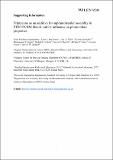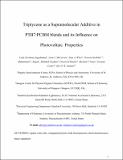Files in this item
Triptycene as a supramolecular additive in PTB7:PCBM blends and its influence on photovoltaic properties
Item metadata
| dc.contributor.author | Krishnan Jagadamma, Lethy | |
| dc.contributor.author | McCarron, Liam | |
| dc.contributor.author | A. Wiles, Alan | |
| dc.contributor.author | Savikhin, Victoria | |
| dc.contributor.author | Sajjad, Muhammad Tariq | |
| dc.contributor.author | Yazdani, Mahdieh | |
| dc.contributor.author | M Rotello, Vincent | |
| dc.contributor.author | F Toney, Michael | |
| dc.contributor.author | Cooke, Graeme | |
| dc.contributor.author | Samuel, Ifor D. W. | |
| dc.date.accessioned | 2020-02-28T17:30:02Z | |
| dc.date.available | 2020-02-28T17:30:02Z | |
| dc.date.issued | 2018-07-25 | |
| dc.identifier | 251545045 | |
| dc.identifier | 903c72a9-4790-4dad-b100-023d00c93146 | |
| dc.identifier | 85049238127 | |
| dc.identifier | 000440511900039 | |
| dc.identifier.citation | Krishnan Jagadamma , L , McCarron , L , A. Wiles , A , Savikhin , V , Sajjad , M T , Yazdani , M , M Rotello , V , F Toney , M , Cooke , G & Samuel , I D W 2018 , ' Triptycene as a supramolecular additive in PTB7:PCBM blends and its influence on photovoltaic properties ' , ACS Applied Materials & Interfaces , vol. 10 , no. 29 , pp. 24665-24678 . https://doi.org/10.1021/acsami.8b03114 | en |
| dc.identifier.issn | 1944-8244 | |
| dc.identifier.other | ORCID: /0000-0002-4339-2484/work/69835139 | |
| dc.identifier.uri | https://hdl.handle.net/10023/19558 | |
| dc.description | We acknowledge support from EPSRC (grant number EP/L012294/1) and the European Research Council (grant number 321305). I. D. W. S. also acknowledges a Royal Society Wolfson Research Merit Award. | en |
| dc.description.abstract | Additives play an important role in modifying the morphology and phase separation of donor and acceptor molecules in bulk heterojunction (BHJ) solar cells. Here, we report triptycene (TPC) as a small-molecule additive for supramolecular control of phase separation and concomitant improvement of the power conversion efficiency (PCE) of PTB7 donor and fullerene acceptor-based BHJ polymer solar cells. An overall 60% improvement in PCE is observed for both PTB7:PC61BM and PTB7:PC71BM blends. The improved photovoltaic (PV) performance can be attributed to three factors: (a) TPC-induced supramolecular interactions with donor:acceptor components in the blends to realize a nanoscale phase-separated morphology; (b) an increase in the charge transfer state energy that lowers the driving force for electron transfer from donor to acceptor molecules; and (c) an increase in the charge carrier mobility. An improvement in efficiency using TPC as a supramolecular additive has also been demonstrated for other BHJ blends such as PBDB-T:PC71BM and P3HT:PCBM, implying the wide applicability of this new additive molecule. A comparison of the photostability of TPC as an additive for PTB7:PCBM solar cells to that of the widely used 1,8-diiodooctane additive shows ∼30% higher retention of PV performance for the TPC-added solar cells after 34 h of AM 1.5G illumination. The results obtained suggest that the approach of using additives that can promote supramolecular interactions to modify the length scale of phase separation between donor and acceptor is very promising and can lead to the development of highly efficient and stable organic photovoltaics. | |
| dc.format.extent | 2207864 | |
| dc.format.extent | 1628237 | |
| dc.language.iso | eng | |
| dc.relation.ispartof | ACS Applied Materials & Interfaces | en |
| dc.subject | QC Physics | en |
| dc.subject | QD Chemistry | en |
| dc.subject | DAS | en |
| dc.subject | SDG 7 - Affordable and Clean Energy | en |
| dc.subject.lcc | QC | en |
| dc.subject.lcc | QD | en |
| dc.title | Triptycene as a supramolecular additive in PTB7:PCBM blends and its influence on photovoltaic properties | en |
| dc.type | Journal article | en |
| dc.contributor.sponsor | EPSRC | en |
| dc.contributor.sponsor | European Research Council | en |
| dc.contributor.institution | University of St Andrews. School of Physics and Astronomy | en |
| dc.contributor.institution | University of St Andrews. Condensed Matter Physics | en |
| dc.identifier.doi | https://doi.org/10.1021/acsami.8b03114 | |
| dc.description.status | Peer reviewed | en |
| dc.date.embargoedUntil | 2019-06-22 | |
| dc.identifier.grantnumber | EP/L012294/1 | en |
| dc.identifier.grantnumber | en |
This item appears in the following Collection(s)
Items in the St Andrews Research Repository are protected by copyright, with all rights reserved, unless otherwise indicated.


